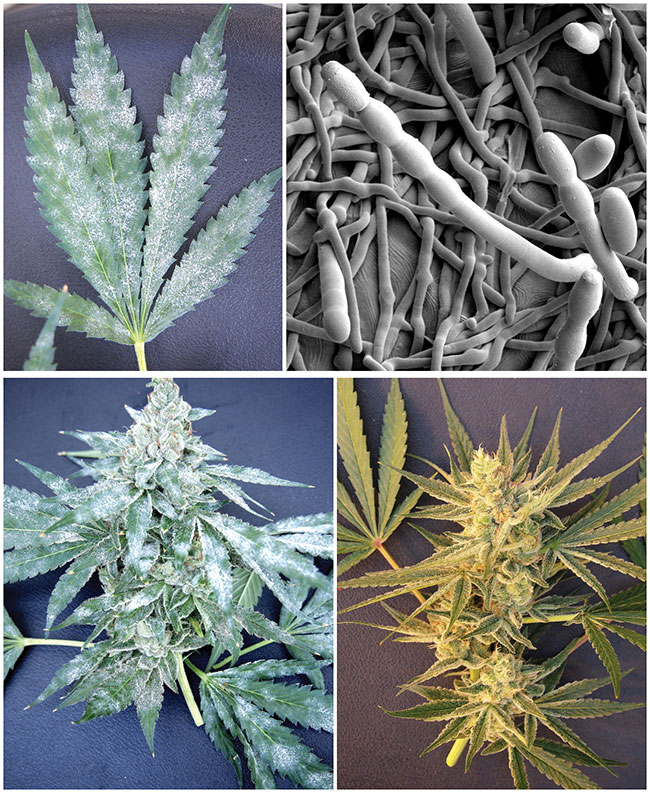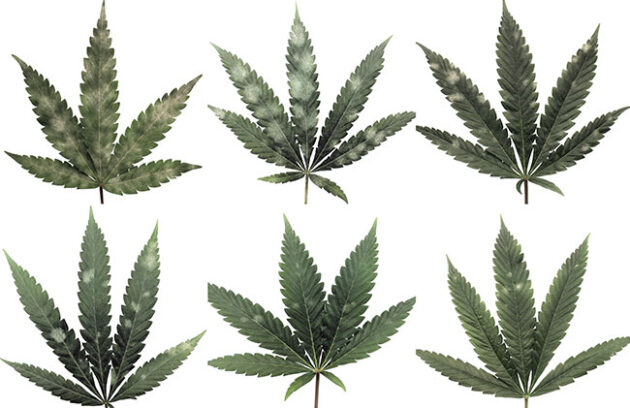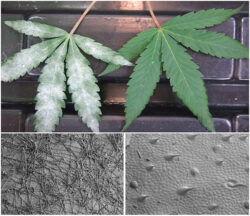
Features
How can powdery mildew on cannabis be managed?
To get the most out of your greenhouse biocontrol program, start with preventative strategies.
December 12, 2022 By Cameron Scott and Dr. Zamir K. Punja
 FIGURE 1
Powdery mildew symptoms on cannabis plants include a white powdery growth of the pathogen on leaves (top left) which is due to mycelial growth and spore production as seen under the scanning electron microscope (top right). Comparison of powdery mildew development on a highly susceptible genotype of cannabis (bottom left) compared to a resistant genotype (bottom right). Both were grown side by side and powdery mildew developed from natural infection under greenhouse conditions. Photographs were taken at harvest time.
FIGURE 1
Powdery mildew symptoms on cannabis plants include a white powdery growth of the pathogen on leaves (top left) which is due to mycelial growth and spore production as seen under the scanning electron microscope (top right). Comparison of powdery mildew development on a highly susceptible genotype of cannabis (bottom left) compared to a resistant genotype (bottom right). Both were grown side by side and powdery mildew developed from natural infection under greenhouse conditions. Photographs were taken at harvest time. Powdery mildew diseases affect a wide range of host species including important greenhouse crops such as tomato, pepper and cucumber, and are caused by different fungal pathogens. On cannabis (Cannabis sativa L.), powdery mildew is caused by Golovinomyces ambrosiae and far less commonly by the pathogen Podosphaera macularis (specifically under field conditions). This disease is easily identified by the characteristic white powdery growth on the upper surface of leaves, as well as on flower tissues or stems of cannabis plants (Figure 1).
Spores of powdery mildew may originate from infected plants within or near the greenhouse, from surfaces that were not sufficiently cleaned between crops and infected plant debris. These spores are moved easily through the air but may also be spread by workers. Following spore germination and infection, fungal colonies that develop can limit photosynthesis and reduce nutrient availability to the plant, causing premature leaf drop as well as reducing overall vigour and potential yield of plants. Powdery mildew infection on cannabis can significantly reduce the quality and marketability of flowers, due to the visible growth of the pathogen on flower tissues (Figure 1).
Disease management approaches
In general, powdery mildews are managed by fungicide application or use of other chemical products, as well as biological control agents, induction of disease resistance, and development of cultivars with genetic resistance. Powdery mildew management on cannabis relies on cultural control methods, such as removal of diseased leaves (deleafing), maintaining relative humidity at levels not conducive for pathogen development, and application of biocontrol products or reduced risk chemicals.
There are currently no synthetic chemical fungicides registered for powdery mildew control on cannabis in Canada unlike on other crops. Several reduced risk chemical products are approved for use by Health Canada, and include potassium bicarbonate, hydrogen peroxide and lactic acid, among others. Other potential methods for disease control, including biological control agents, application of ultraviolet (UV) light, or use of disease resistant cultivars, have not been previously evaluated for cannabis.
Study Objectives
In this study, we evaluated potential disease control methods for powdery mildew management on cannabis. Three biological control agents, namely Actinovate SP (containing Streptomyces lydicus strain WYEC 108), Rhapsody ASO (containing Bacillus subtilis strain QST 713) and Stargus (containing Bacillus amyloliquefaciens strain F727) were tested. Chemical treatments evaluated included MilStop (potassium bicarbonate), ZeroTol (hydrogen peroxide) and the plant defence inducer Regalia Maxx (containing an extract of Reynoutria sachalinensis). In addition, the efficacy of UV-C light to manage powdery mildew was also examined by daily exposure of leaves. Finally, the susceptibility of different cultivars (genotypes) of cannabis to disease development was assessed to determine their resistance to powdery mildew.
Experimental approach
All treatments were applied to cannabis cultivar Copenhagen Kush, which is highly susceptible to powdery mildew. Cuttings were rooted and grown in an indoor room with 24-hour lighting. To initiate powdery mildew infection, a diseased cannabis plant grown in a licenced facility in British Columbia provided a source of spores used to infect plants. A single heavily infected plant was placed in the centre of the room and allowed to release conidia. This ensured that background levels of inoculum in the indoor room where the experiments were conducted were sufficient for the disease to establish naturally. Rooted plants received one spray of MilStop to minimize any variance in the initial levels of infection. The plants were then maintained for seven days in the growing room before treatments were applied.
At the start of the experiment (week 0), plants were assessed for powdery mildew infection, after which they received the appropriate treatment. Plants received four weekly sprays in total and five disease assessments were made at weekly intervals. Disease was assessed on the 30 most diseased leaflets (assessed visually) per group by placing them into one of five categories, based on the percentage coverage of leaves by mildew. These ratings were then utilized to calculate a disease rating score for each plant. The experiments were conducted three times per treatment group.

FIGURE 2
Comparison of five treatments tested against powdery mildew development. Leaves show disease after 4 treatments applied weekly compared to an untreated control. Top row: Untreated Control, Actinovate, Rhapsody. Bottom row: ZeroTol, Milstop, Regalia Maxx.
Foliar sprays that reduce powdery mildew
The disease progression on treated and control (untreated) plants was plotted on a graph to generate a disease progress curve which could be used to compare the efficacy of treatments. Based on these comparisons, the most effective treatments, which significantly reduced disease in all three trials, were Regalia Maxx, MilStop, Rhapsody ASO and Stargus. Treatments of Actinovate SP and ZeroTol showed less efficacy and were only effective in managing powdery mildew in one or two trials, respectively (Figure 2).
Ultraviolet light treatments

FIGURE 3
UV-C treatments used daily reduced powdery mildew development (top right leaf) compared to untreated plants (top left leaf). Mildew developed extensively on untreated plants (bottom left) compared to treated plants (bottom right).
An ultraviolet treatment was also tested for powdery mildew control. The treated plants received daily exposure to UV-C light from a handheld CleanLight Pro unit over four weeks. Plants were treated for 3s to 5s per day (equal to 3–6 mJ/cm2 of radiation, as per the manufacturer) by moving the unit uniformly over and around the plants at a distance of 5 cm away. Treated and control plants were rated for disease as described above. In two trials, UV-C light significantly reduced powdery mildew development, and after 30 days, the plants were free of infection on new growth (Figure 3). Scanning electron microscopic observations of treated cannabis leaves showed that mildew spores had not germinated, and mycelial growth was inhibited, suggesting a direct toxic effect from these treatments.
Cannabis genotypes differ in susceptibility
A comparison was made of 12 genotypes of cannabis grown for two weeks under a humidity dome in the presence of infected Copenhagen Kush plants. Entire plants were rated for disease by placing them into one of five categories based on the percentage coverage of powdery mildew on the leaves, as described previously. The average disease score per genotype was determined and significant differences were determined using statistical tests. The experiment was conducted twice. Among the 12 genotypes, seven showed partial or complete resistance to infection (Figure 4). Differing levels of susceptibility to powdery mildew infection have also been observed among hemp cultivars. Efforts are underway in several research laboratories to identify the resistant genes involved which will also allow them to be used in marker assisted breeding of cannabis with improved powdery mildew resistance.

FIGURE 4
Comparison of powdery mildew development on leaves of three genotypes of cannabis. From left to right: ‘Space Queen’, ‘Pennywise’, ‘Sweet Durga Mata’.
This article summarizes results of experiments conducted as part of Cameron Scott’s M.Sc. study at Simon Fraser University. More detailed results from this study have been published as an open access scientific paper in the Canadian Journal of Plant Pathology. This manuscript is available at the following weblink: https://www.tandfonline.com/doi/full/10.1080/07060661.2020.1836026
Print this page